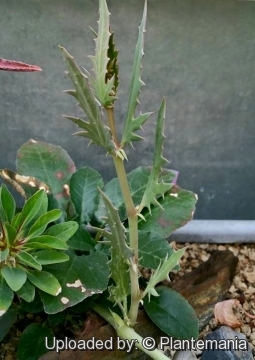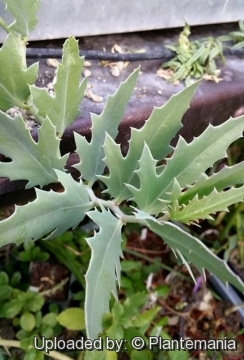




Your support is critical to our success.

Origin and Habitat: Northeastern South Africa, including Limpopo Province and the northern part of Mpumalanga.
Altitude range 800-1500 metres above sea level.
Habitat and ecology. Cyphostemma segmentatumSN|33566]]SN|33566]] grows amongst boulders on rocky mountain slopes in hot, arid regions with summer rains and dry winters. It is a very rare species that grow intermixed with other succulents and xerophyte plants such as: Aloe marlothiiSN|23355]]SN|23355]], Cissus quadrangularisSN|33662]]SN|33662]], Euphorbia cooperiSN|21563]]SN|21563]], Huernia zebrinaSN|21240]]SN|21240]] subsp. magniflora, Kleinia longifloraSN|32931]]SN|32931]], Monadenium lugardiae, Orbeopsis valida, Sansevieria aethiopica, Sarcostemma viminaleSN|27584]]SN|27584]], and Stapelia gettliffei.
Synonyms:
- Cyphostemma segmentatum (C.A.Sm.) J.J.M.van der Merwe
- Cissus segmentata C.A.Sm.
RUSSIAN (Русский): Цифостемма отороченная
Description: Cyphostemma segmentatumSN|33566]]SN|33566]] is a rare and distinctive perennial caudiciform, with a massive caudex and aerial, annual, scrambling, stems up to 1.3 m long.
Bibliography: Major references and further lectures
1) N. L. Meyer “Plants of Southern Africa: An Annotated Checklist” National Botanical Institute, 01 January 2003
2) J. van derMerwe, 1971 In: Bothalia, 10(3): 436
3) Foden, W. & Potter, L. 2005. Cyphostemma segmentatum (C.A.Sm.) J.J.M.van der Merwe. National Assessment: Red List of South African Plants version 2015.1. Accessed on 2017/01/11
4) Charles Craib “Cyphostemma segmentatum In Sekhukhuneland” Cactus and Succulent Journal 78(3):142-145. 2006
5) van Wyk, A. E. and G. F. Smith. “Regions of Floristic Endemism in Southern Africa” Umdaus Press. Hatfield Pretoria. 2001.
6) Noel van Rooyen “The vegetation types and veld condition of Maremani” August 2002 <http://www.maremani.com/wp-content/uploads/2013/02/The_vegetation_types_and_veld_condition_of_Maremani.pdf>

Cyphostemma segmentatum Photo by: © Plantemania

Cyphostemma segmentatum Photo by: © Plantemania
Cultivation and Propagation: Cyphostemma pachypusSN|33422]]SN|33422]] should make an interesting addition to a collection, but is rare in cultivation. It is suited to greenhouse culture, but does well outdoors in subtropical climates. It doesn't like a wet winter, but will survive.
Growth rate: It grows well, though very slowly, but it possible to increase the speed of growth to some extent by providing adequate amount of water, warmth, and fertilizer during the active growing season, but it’s susceptible to rotting if too wet.
Exposure: It needs Full sun to light shade, but the caudex should be in the shade, while the leaves prefer the sun. Avoid direct blasting sun in summer.
Soil: It needs a a rich, very well drained potting medium (add pumice, vulcanite, and perlite).
Waterings: It should be watered plentifully in Summer and kept drier in Winter. This species like all pachycaul succulent species of Cyphostemma, is sensitive to excess moisture, and should be kept on the dry side. It rot easily and do NOT like a lot of water when it has no leaves.
Frost tolerance: Due to its African origin keep warm in winter, the minimum safe average temperature is 10°C, although it can go lower for short periods. It can be grown outdoors in frost-free climates, need anyway to kept above 2°C and dry in winter. Can't stand any frost.
Maintenance: Repot every two years. It like pots with generous drain holes.
Propagation: The plants for decoration are grown from seed since they develop a perfect caudex. The seeds that must be prepared, aged and scarified, and even then germination is uncertain (cuttings are possible, but don't generally produce a caudex).
| Your Actions | |
|---|---|
| Back to Cyphostemma index | |
| Back to Vitaceae index | |
 |
Back to Succulents Encyclopedia index |
Privacy stantement - Terms and conditions - How to cite - About us - Feedback - Donate



